NJ (908) 688-5577
NY (212) 737-2528
Broken Feet
A broken foot can either refer to a fracture or a straight break. The location of any break can tell you how the break happened. Toes, for instance, break typically as a result of something being kicked hard and with great force. Heel breaks almost always are a result of an improper landing from a tall height. Twists or sprains are the other two frequent occurrences. As with all usual breaks, they result from unexpected accident or sudden injury. As with stress fractures, breaks form as a process over time from repeated stress on already present cracks. Runners, dancers, and gymnasts are the usual athletes who receive this type of break. Stress fractures result from incredible pressure on the feet. It is no surprise these athletes bear the majority of reported fractures.
Pain, swelling, bruising, and redness are all indicative of the typical symptoms from a broken foot. Severe pain—to the point of not being able to walk—usually depends on the location of the break in the foot. Toes are on the lower scale of pain threshold, but heels are high, as are a few other particular bones. As the severity of the broken foot increases, symptoms like blueness, numbness, misshaping of the foot, cuts, or deformities will become apparent. These symptoms indicate the need to see a medical professional with access to an x-ray facility.
Prior to seeing a specialist, precautions should be taken to reduce pain and swelling. Elevate and stabilize the foot, and refrain from moving it. Immobilization of the foot is the next priority, so creating a homemade splint is acceptable. Keep in mind that while creating a splint, any increase of pain or cutting off blood circulation means that the splint should be removed immediately. Use ice to decrease swelling and relieve pain symptoms.
When dealing with a medical center, the patient should note that the treatment can vary. The treatment will depend on the severity of the fracture and the cause of the break. Crutches, splits, or casts are common treatments while surgery has been known to be used in more severe cases in order to repair the break in the bones.
Broken Ankles
Broken ankles are a serious injury that can lead to an inability to walk, function, and also cause a significant amount of pain. A broken ankle is a break in one of the three bones in your body that connect at the ankle joint, the tibia, the fibula, and the talus. The tibia and fibula are your two primary leg bones that connect at the knee, which sits directly upon the talus bone. This is protected by a fibrous membrane that allows for movement in our ankle joint. A broken ankle is usually caused by the foot rolling under or twisting too far, causing one of these three bones to snap.
A broken ankle is different from an ankle sprain, which occurs when the ligaments are ripped or torn but no bones have been broken. A sprain can still be very severe, causing bruising in the foot and an inability to hold your own weight, much like a broken ankle would. If you’re unable to stand, and suspect that you have a broken ankle, the first thing to do would be to get an immediate x-ray to determine the severity of the break.
A common cause of broken ankles is when the ankle is rolled over with enough pressure to break the bones. This usually happens during exercise, sports, or other physical activities. Another common cause is a fall or jump from a tall height.
One immediate treatment for pain relief is elevating the feet above your head to reduce blood flow to the injured area. You can also apply ice packs to your ankles to help reduce swelling, redness, inflammation, and pain. After these initial steps, getting a cast and staying off your feet as much as possible will aid in the recovery of the broken ankle. The less movement and stress the ankle has to endure, the more complete it will heal. A doctor can determine if surgery is needed in order to heal correctly. In these cases, an operation may be the only option to ensure the ability to walk properly again, followed by physical therapy and rehabilitation.
It is highly important to determine if surgery is needed early on, because a broken ankle can become much more severe than you realize. If not professionally treated, the broken ankle will inhibit your walking, daily functioning, and produce a large amount of pain. Treating your broken ankle early on will help prevent further damage to it.
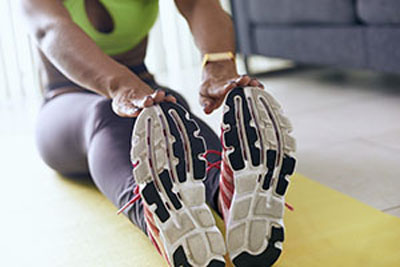 Many people consider the sport or hobby of running to be extremely beneficial in relieving stress. The importance of properly stretching and warming up the muscles is crucial if you want to engage in this type of sport for an extended period. A common running injury that is known as Achilles tendinitis is common among runners and joggers. This injury can be felt near the lower part of the back of the leg and may be strengthened by rising up on the toes, followed by gently lowering the heels. This stretch may be helpful in loosening tight calf muscles, which may cause Achilles tendons injuries. Additionally, plantar fasciitis is among one of the more common injuries that runners may experience. This will typically affect the heel, and pain and discomfort in that area may be indicative of this injury. Preventive measures may include wearing shoes that have adequate support, and this may mean to avoid wearing high heels and flip-flops. If you would like additional information about how to prevent running injuries, it is advised to seek the counsel of a podiatrist.
Many people consider the sport or hobby of running to be extremely beneficial in relieving stress. The importance of properly stretching and warming up the muscles is crucial if you want to engage in this type of sport for an extended period. A common running injury that is known as Achilles tendinitis is common among runners and joggers. This injury can be felt near the lower part of the back of the leg and may be strengthened by rising up on the toes, followed by gently lowering the heels. This stretch may be helpful in loosening tight calf muscles, which may cause Achilles tendons injuries. Additionally, plantar fasciitis is among one of the more common injuries that runners may experience. This will typically affect the heel, and pain and discomfort in that area may be indicative of this injury. Preventive measures may include wearing shoes that have adequate support, and this may mean to avoid wearing high heels and flip-flops. If you would like additional information about how to prevent running injuries, it is advised to seek the counsel of a podiatrist.
Exercising your feet regularly with the proper foot wear is a great way to prevent injuries. If you have any concerns about your feet, contact Glenn Davison, DPM of Advanced Podiatry. Our doctor will treat your foot and ankle needs.
How to Prevent Running Injuries
Many common running injuries are caused by overuse and overtraining. When the back of the kneecap starts wearing out and starts causing pain in your knee, this is commonly referred to as runner’s knee. Runner’s knee is a decrease in strength in your quadriceps and can occur if you’re not wearing properly fitted or supporting shoes. To prevent runner’s knee, focusing on hip strengthening is a good idea, as well as strengthening your quads to keep the kneecaps aligned.
What Are Some Causes of Running Injuries?
- One cause of a common running injury is called iliotibial band syndrome.
- Plantar fasciitis is also another common injury.
- Stress fractures can occur from overtraining, lack of calcium, or even your running style.
Best Ways to Prevent Running Injuries
- Wear footwear that fits properly and suits your running needs.
- Running shoes are the only protective gear that runners have to safeguard them from injury.
- Make a training schedule. Adding strengthening exercises as well as regular stretching can help keep you strong and limber and can lessen the possibility of injuries.
- Stretching keeps muscles limber; this will help you gain better flexibility.
If you have any questions please feel free to contact our offices located in Union, NJ and New York . We offer the newest diagnostic and treatment technologies for all your foot and ankle needs.
 A common part of the foot where arthritis may develop is the toes. There are several joints that are located in the toes, and if inflammation should occur, arthritis may develop. This may typically cause severe pain and discomfort. There are several reasons why patients may develop toe arthritis, and these can include becoming overweight, hereditary factors, or the natural aging process. Additionally, women who choose to wear shoes that do not provide adequate room for the toes to move freely may also develop this uncomfortable foot condition. Many patients experience pain as the first symptom, and this may hinder performing everyday activities. Other symptoms may include swelling in and around the joints in the toes, possible stiffness as a result of diminished cartilage between the joints, or heat emanating from that area of the foot. If you believe you have the beginning stages of arthritis developing in your toes, speak with a podiatrist who can properly examine your condition.
A common part of the foot where arthritis may develop is the toes. There are several joints that are located in the toes, and if inflammation should occur, arthritis may develop. This may typically cause severe pain and discomfort. There are several reasons why patients may develop toe arthritis, and these can include becoming overweight, hereditary factors, or the natural aging process. Additionally, women who choose to wear shoes that do not provide adequate room for the toes to move freely may also develop this uncomfortable foot condition. Many patients experience pain as the first symptom, and this may hinder performing everyday activities. Other symptoms may include swelling in and around the joints in the toes, possible stiffness as a result of diminished cartilage between the joints, or heat emanating from that area of the foot. If you believe you have the beginning stages of arthritis developing in your toes, speak with a podiatrist who can properly examine your condition.
Arthritis can be a difficult condition to live with. If you are seeking treatment, contact Glenn Davison, DPM from Advanced Podiatry. Our doctor can provide the care you need to keep you pain-free and on your feet.
Arthritic Foot Care
Arthritis is a joint disorder that involves the inflammation of different joints in your body, such as those in your feet. Arthritis is often caused by a degenerative joint disease and causes mild to severe pain in all affected areas. In addition to this, swelling and stiffness in the affected joints can also be a common symptom of arthritis.
In many cases, wearing ill-fitting shoes can worsen the effects and pain of arthritis. Wearing shoes that have a lower heel and extra room can help your feet feel more comfortable. In cases of rheumatoid arthritis, the arch in your foot may become problematic. Buying shoes with proper arch support that contour to your feet can help immensely.
Alleviating Arthritic Pain
It is best to see your doctor for the treatment that is right for your needs and symptoms. Conditions vary, and a podiatrist can help you determine the right method of care for your feet.
If you have any questions, please feel free to contact our offices located in Union, NJ and New York . We offer the newest diagnostic tools and technology to treat your foot and ankle needs.
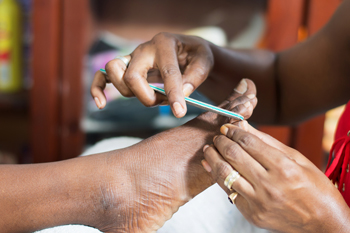 Many diabetic patients are aware of the importance of properly taking care of their feet. A common condition that can affect this group of people may be a form of neuropathy, and this may inhibit the ability to feel any wounds or cuts that may be present on the feet. Additionally, the skin may become dry as a result of being diabetic, and measures can be taken that may provide moderate relief. This may include washing and drying the feet thoroughly, followed by utilizing a good moisturizer on most of the foot. It’s important to avoid applying this product between the toes, which may aid in preventing a possible infection. Diabetics may experience foot ulcers, which is an uncomfortable and painful condition that occurs on the bottom of the foot or under the big toe. If you are experiencing any of these symptoms, it is strongly suggested to consult with a podiatrist as quickly as possible who can determine the best course of treatment for you.
Many diabetic patients are aware of the importance of properly taking care of their feet. A common condition that can affect this group of people may be a form of neuropathy, and this may inhibit the ability to feel any wounds or cuts that may be present on the feet. Additionally, the skin may become dry as a result of being diabetic, and measures can be taken that may provide moderate relief. This may include washing and drying the feet thoroughly, followed by utilizing a good moisturizer on most of the foot. It’s important to avoid applying this product between the toes, which may aid in preventing a possible infection. Diabetics may experience foot ulcers, which is an uncomfortable and painful condition that occurs on the bottom of the foot or under the big toe. If you are experiencing any of these symptoms, it is strongly suggested to consult with a podiatrist as quickly as possible who can determine the best course of treatment for you.
Diabetic foot care is important in preventing foot ailments such as ulcers. If you are suffering from diabetes or have any other concerns about your feet, contact Glenn Davison, DPM from Advanced Podiatry. Our doctor can provide the care you need to keep you pain-free and on your feet.
Diabetic Foot Care
Diabetes affects millions of people every year. The condition can damage blood vessels in many parts of the body, especially the feet. Because of this, taking care of your feet is essential if you have diabetes, and having a podiatrist help monitor your foot health is highly recommended.
The Importance of Caring for Your Feet
Patients with diabetes should have their doctor monitor their blood levels, as blood sugar levels play such a huge role in diabetic care. Monitoring these levels on a regular basis is highly advised.
It is always best to inform your healthcare professional of any concerns you may have regarding your feet, especially for diabetic patients. Early treatment and routine foot examinations are keys to maintaining proper health, especially because severe complications can arise if proper treatment is not applied.
If you have any questions please feel free to contact our offices located in Union, NJ and New York . We offer the newest diagnostic and treatment technologies for all your foot and ankle needs.
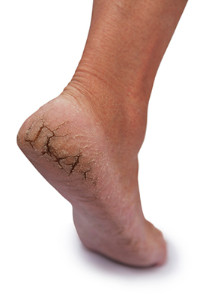 Patients who suffer from the unsightly condition that is known as cracked heels may be familiar with the pain and discomfort, which may be associated with this ailment. It is defined as deep cracks, which may also be known as fissures, which form on the heel of the foot. It may originate from wearing shoes that have open backs, which do not provide adequate support the heels need, in addition to having medical conditions such as obesity, psoriasis, or dermatitis. Research has shown that patients who experience underactive thyroid imbalances may develop cracked heels. This may be a result of sweat glands, located in the feet, being under regulated, and can possibly cause the skin to become excessively dry. If you have developed cracked heels, it is strongly advised to consult with a podiatrist who can determine the cause of this condition and guide you to begin correct treatment.
Patients who suffer from the unsightly condition that is known as cracked heels may be familiar with the pain and discomfort, which may be associated with this ailment. It is defined as deep cracks, which may also be known as fissures, which form on the heel of the foot. It may originate from wearing shoes that have open backs, which do not provide adequate support the heels need, in addition to having medical conditions such as obesity, psoriasis, or dermatitis. Research has shown that patients who experience underactive thyroid imbalances may develop cracked heels. This may be a result of sweat glands, located in the feet, being under regulated, and can possibly cause the skin to become excessively dry. If you have developed cracked heels, it is strongly advised to consult with a podiatrist who can determine the cause of this condition and guide you to begin correct treatment.
Cracked heels are unsightly and can cause further damage to your shoes and feet. If you have any concerns, contact Glenn Davison, DPM from Advanced Podiatry. Our doctor can provide the care you need to keep you pain-free and on your feet.
Cracked Heels
Cracked heels appear unappealing and can make it harder for you walk around in sandals. Aside from looking unpleasant, cracked heels can also tear stockings, socks, and wear out your shoes. There are several methods to help restore a cracked heel and prevent further damage.
How Do You Get Them?
Dry skin is the number one culprit in creating cracked heels. Many athletes, walkers, joggers, and even swimmers suffer from cracked heels. Age and skin oil production play a role to getting cracked heels as well.
Promote Healing
Over the counter medicines can help, especially for those that need instant relief or who suffer from chronic dry feet.
Wear Socks – Wearing socks with medicated creams helps lock in moisture.
Moisturizers – Applying both day and night will help alleviate dryness which causes cracking.
Pumice Stones – These exfoliate and remove dead skin, which allows for smoother moisturizer application and better absorption into the skin.
Change in Diet
Eating healthy with a well-balanced diet will give the skin a fresh and radiant look. Your body responds to the kinds of food you ingest. Omega-3 fatty acids and zinc supplements can also revitalize skin tissue.
Most importantly, seek professional help if unsure how to proceed in treating cracked heels. A podiatrist will help you with any questions or information needed.
If you have any questions, please feel free to contact our offices located in Union, NJ and New York . We offer the newest diagnostic and treatment technologies for all your foot care needs.
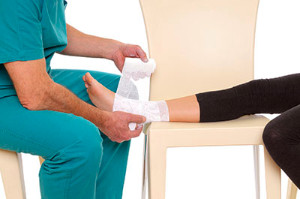 If you have fallen unexpectedly or stepped abruptly off a curb, you may have had the displeasure of experiencing an ankle sprain. It is typically the result of the ankle suddenly twisting or rolling, which may move the ankle out of alignment. There are several ligaments that surround the ankle and may tear if an ankle sprain occurs. There are several symptoms that may be associated with this condition, including noticeable swelling, bruising, and difficulty in bearing weight on the ankle. It’s important to have a proper diagnosis performed, which most likely may include having an X-ray taken. An MRI may be prescribed if the ankle sprain appears to be of a serious nature, or if damage has occurred to the surface of the ankle joint. There are many ways to treat a broken ankle, and this may depend on the severity of the injury. If you feel you have sprained your ankle, it is advised to consult with a podiatrist as quickly as possible who can determine the best course of treatment for you.
If you have fallen unexpectedly or stepped abruptly off a curb, you may have had the displeasure of experiencing an ankle sprain. It is typically the result of the ankle suddenly twisting or rolling, which may move the ankle out of alignment. There are several ligaments that surround the ankle and may tear if an ankle sprain occurs. There are several symptoms that may be associated with this condition, including noticeable swelling, bruising, and difficulty in bearing weight on the ankle. It’s important to have a proper diagnosis performed, which most likely may include having an X-ray taken. An MRI may be prescribed if the ankle sprain appears to be of a serious nature, or if damage has occurred to the surface of the ankle joint. There are many ways to treat a broken ankle, and this may depend on the severity of the injury. If you feel you have sprained your ankle, it is advised to consult with a podiatrist as quickly as possible who can determine the best course of treatment for you.
Although ankle sprains are common, they aren’t always minor injuries. If you need your ankle injury looked at, contact Glenn Davison, DPM from Advanced Podiatry. Our doctor can provide the care you need to keep you pain-free and on your feet.
How Does an Ankle Sprain Occur?
Ankle sprains are the result of a tear in the ligaments within the ankle. These injuries may happen when you make a rapid shifting movement while your foot is planted. A less common way to sprain your ankle is when your ankle rolls inward while your foot turns outward.
What Are the Symptoms?
Preventing a Sprain
Treatment of a Sprain
In many cases, the RICE method (Rest, Ice, Compression, and Elevate) is used to treat ankle sprains. However, you should see a podiatrist to see which treatment option would work best with your injury. In severe cases, surgery may be required.
It is important to ask your doctor about rehab options after you receive treatment for your injury. Stretching, strength training, and balance exercises may help the ankle heal while also preventing further injury.
If you have any questions, please feel free to contact our offices located in Union, NJ and New York . We offer the newest diagnostic and treatment technologies for all your foot care needs.
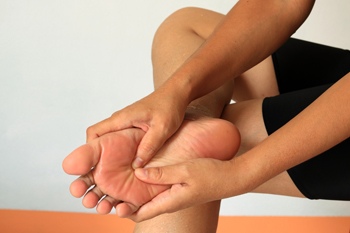 Morton’s neuroma is the medical term described as an uncomfortable foot condition that is typically located on the bottom of the foot under the third and fourth toes. If the nerve that lies there becomes irritated and swollen, you may experience symptoms that include a tingling or burning sensation, or pain inside the ball of the foot. These symptoms may develop over time and this may depend on what type of shoes are worn or the activities that are performed. Common causes for this condition to develop may come from shoes that do not have adequate room for the toes to move about in, or shoes that exert excess pressure on the ball of the foot. It’s suggested to consult with a podiatrist if you feel you have developed this ailment to discuss proper treatment options.
Morton’s neuroma is the medical term described as an uncomfortable foot condition that is typically located on the bottom of the foot under the third and fourth toes. If the nerve that lies there becomes irritated and swollen, you may experience symptoms that include a tingling or burning sensation, or pain inside the ball of the foot. These symptoms may develop over time and this may depend on what type of shoes are worn or the activities that are performed. Common causes for this condition to develop may come from shoes that do not have adequate room for the toes to move about in, or shoes that exert excess pressure on the ball of the foot. It’s suggested to consult with a podiatrist if you feel you have developed this ailment to discuss proper treatment options.
Morton’s neuroma is a very uncomfortable condition to live with. If you think you have Morton’s neuroma, contact Glenn Davison, DPM of Advanced Podiatry. Our doctor will attend to all of your foot care needs and answer any of your related questions.
Morton’s Neuroma
Morton's neuroma is a painful foot condition that commonly affects the areas between the second and third or third and fourth toe, although other areas of the foot are also susceptible. Morton’s neuroma is caused by an inflamed nerve in the foot that is being squeezed and aggravated by surrounding bones.
What Increases the Chances of Having Morton’s Neuroma?
Morton’s neuroma is a very treatable condition. Orthotics and shoe inserts can often be used to alleviate the pain on the forefront of the feet. In more severe cases, corticosteroids can also be prescribed. In order to figure out the best treatment for your neuroma, it’s recommended to seek the care of a podiatrist who can diagnose your condition and provide different treatment options.
If you have any questions, please feel free to contact our offices located in Union, NJ and New York . We offer the newest diagnostic and treatment technologies for all your foot care needs.
 There are many children who experience low muscle tone in their feet, and this may lead to a condition that is referred to as flat feet. The structure of the foot may be altered, and it may be noticeable if the feet are far apart and turned outward while standing. There are several tendons and ligaments that support the bones of the feet, and those children who are afflicted with flat feet may experience limited stability to the joints of the foot. Additionally, the balance of the body may be negatively affected when these particular muscles are weak, and may generally affect the overall symmetry of the body. Research has shown the tendon that connects the heel to the toes is known as the plantar fascia. This portion of tissue may provide less than adequate support for the arch if low arches in the feet are present. If your child has this condition, it’s suggested to speak with a podiatrist for additional important information relating to flat feet.
There are many children who experience low muscle tone in their feet, and this may lead to a condition that is referred to as flat feet. The structure of the foot may be altered, and it may be noticeable if the feet are far apart and turned outward while standing. There are several tendons and ligaments that support the bones of the feet, and those children who are afflicted with flat feet may experience limited stability to the joints of the foot. Additionally, the balance of the body may be negatively affected when these particular muscles are weak, and may generally affect the overall symmetry of the body. Research has shown the tendon that connects the heel to the toes is known as the plantar fascia. This portion of tissue may provide less than adequate support for the arch if low arches in the feet are present. If your child has this condition, it’s suggested to speak with a podiatrist for additional important information relating to flat feet.
Flatfoot is a condition many people suffer from. If you have flat feet, contact Glenn Davison, DPM from Advanced Podiatry. Our doctor will treat your foot and ankle needs.
What Are Flat Feet?
Flatfoot is a condition in which the arch of the foot is depressed and the sole of the foot is almost completely in contact with the ground. About 20-30% of the population generally has flat feet because their arches never formed during growth.
Conditions & Problems:
Having flat feet makes it difficult to run or walk because of the stress placed on the ankles.
Alignment – The general alignment of your legs can be disrupted, because the ankles move inward which can cause major discomfort.
Knees – If you have complications with your knees, flat feet can be a contributor to arthritis in that area.
Symptoms
Treatment
If you are experiencing pain and stress on the foot you may weaken the posterior tibial tendon, which runs around the inside of the ankle.
If you have any questions please feel free to contact our offices located in Union, NJ and New York . We offer the newest diagnostic and treatment technologies for all your foot and ankle needs.
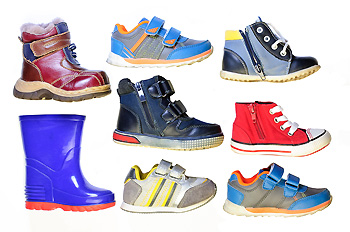 Research has shown the importance of teaching children at a young age how to perform proper foot care. This process may begin with educating the child about their feet. For example, feet are comprised of 26 bones, and the strongest two are the heel bone and the talus bone. These bones carry the majority of the body’s weight as daily activities are pursued. Additionally, proper foot hygiene is important to learn and practice daily, and this may prevent certain uncomfortable foot conditions from developing. This may be accomplished by washing and drying the feet thoroughly every day, walking barefoot in the house, which may aid in helping to spread the toes out, and learning how to trim the toenails properly. Additionally, it’s important for the child to notice any pain or discomfort in their feet, which may be a result of improperly fitting shoes or socks. If this should occur, it’s suggested to visit a podiatrist who can help guide the parents in learning about proper foot care for their child.
Research has shown the importance of teaching children at a young age how to perform proper foot care. This process may begin with educating the child about their feet. For example, feet are comprised of 26 bones, and the strongest two are the heel bone and the talus bone. These bones carry the majority of the body’s weight as daily activities are pursued. Additionally, proper foot hygiene is important to learn and practice daily, and this may prevent certain uncomfortable foot conditions from developing. This may be accomplished by washing and drying the feet thoroughly every day, walking barefoot in the house, which may aid in helping to spread the toes out, and learning how to trim the toenails properly. Additionally, it’s important for the child to notice any pain or discomfort in their feet, which may be a result of improperly fitting shoes or socks. If this should occur, it’s suggested to visit a podiatrist who can help guide the parents in learning about proper foot care for their child.
Making sure that your children maintain good foot health is very important as they grow. If you have any questions, contact Glenn Davison, DPM of Advanced Podiatry. Our doctor can provide the care you need to keep you pain-free and on your feet.
Keeping Children's Feet Healthy
Having healthy feet during childhood can help prevent medical problems later in life, namely in the back and legs. As children grow, their feet require different types of care. Here are some things to consider...
Although babies do not walk yet, it is still very important to take care of their feet.
Avoid putting tight shoes or socks on his or her feet.
Allow the baby to stretch and kick his or her feet to feel comfortable.
As a toddler, kids are now on the move and begin to develop differently. At this age, toddlers are getting a feel for walking, so don’t be alarmed if your toddler is unsteady or ‘walks funny’.
As your child gets older, it is important to teach them how to take care of their feet.
Show them proper hygiene to prevent infections such as fungus.
Be watchful for any pain or injury.
Have all injuries checked by a doctor as soon as possible.
Comfortable, protective shoes should always be worn, especially at play.
If you have any questions please feel free to contact our offices located in Union, NJ and New York . We offer the newest diagnostic and treatment technologies for all your foot and ankle needs.
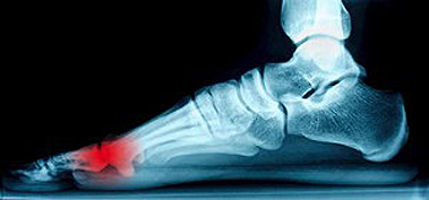 The bones that are found surrounding the joints in the foot are referred to as sesamoid bones. Research has confirmed the big toe contains different types of these particular bones and they have specific functions, which includes providing stability while walking. If an injury should occur to one or more of these bones, inflammation is likely to develop and this typically results in severe pain and discomfort. This is referred to as sesamoiditis, and generally occurs from repetitive activity that may be associated with dancing, basketball, or tennis. Patients who experience this condition often notice gradual pain developing in the foot, in addition to swelling and tenderness surrounding the affected joint. The first phase of treatment will often include rest and cessation from the activity that has caused this ailment. It’s suggested to speak to a podiatrist if you are afflicted with sesamoiditis for further treatment options that are correct for you.
The bones that are found surrounding the joints in the foot are referred to as sesamoid bones. Research has confirmed the big toe contains different types of these particular bones and they have specific functions, which includes providing stability while walking. If an injury should occur to one or more of these bones, inflammation is likely to develop and this typically results in severe pain and discomfort. This is referred to as sesamoiditis, and generally occurs from repetitive activity that may be associated with dancing, basketball, or tennis. Patients who experience this condition often notice gradual pain developing in the foot, in addition to swelling and tenderness surrounding the affected joint. The first phase of treatment will often include rest and cessation from the activity that has caused this ailment. It’s suggested to speak to a podiatrist if you are afflicted with sesamoiditis for further treatment options that are correct for you.
Sesamoiditis is an unpleasant foot condition characterized by pain in the balls of the feet. If you think you’re struggling with sesamoiditis, contact Glenn Davison, DPM of Advanced Podiatry. Our doctor will treat your condition thoroughly and effectively.
Sesamoiditis
Sesamoiditis is a condition of the foot that affects the ball of the foot. It is more common in younger people than it is in older people. It can also occur with people who have begun a new exercise program, since their bodies are adjusting to the new physical regimen. Pain may also be caused by the inflammation of tendons surrounding the bones. It is important to seek treatment in its early stages because if you ignore the pain, this condition can lead to more serious problems such as severe irritation and bone fractures.
Causes of Sesamoiditis
Treatment for sesamoiditis is non-invasive and simple. Doctors may recommend a strict rest period where the patient forgoes most physical activity. This will help give the patient time to heal their feet through limited activity. For serious cases, it is best to speak with your doctor to determine a treatment option that will help your specific needs.
If you have any questions please feel free to contact our offices located in Union, NJ and New York . We offer the newest diagnostic and treatment technologies for all your foot and ankle needs.